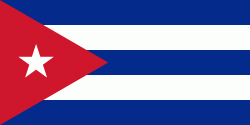Museum of the Revolution (Revolutionsmuseum)
The Museum of the Revolution (Museo de la Revolución) is located in the Old Havana section of Havana, Cuba, in what was the Presidential Palace of all Cuban presidents from Mario García Menocal to Fulgencio Batista. The building became the Museum of the Revolution during the years following the Cuban Revolution. The palace building was attacked by the Directorio Revolucionario Estudiantil in 1957.
The Presidential Palace was designed by the Cuban architect Rodolfo Maruri and the Belgian architect Paul Belau who also designed the Centro Gallego, presently the Gran Teatro de La Habana. The Presidential Palace was inaugurated in 1920 by President Mario García Menocal. It remained the Presidential Palace until the Cuban Revolution of 1959. The building has Neo-Classical elements and was decorated by Tiffany Studios of New York City.
The building was the site of an attack in March 1957 where the Directorio Revolucionario Estudiantil from the University of Havana attempted to kill Fulgencio Batista. It was a two-prong attack which included the take over of Radio Relox at the Radiocentro CMQ Building. Both attacks failed. According to one of the attackers, Faure Chomón of the Revolutionary Directorate, they were following the golpe arriba strategy and together with Menelao Mora Morales sought to overthrow the government by killing President Fulgencio Batista.
The Presidential Palace was designed by the Cuban architect Rodolfo Maruri and the Belgian architect Paul Belau who also designed the Centro Gallego, presently the Gran Teatro de La Habana. The Presidential Palace was inaugurated in 1920 by President Mario García Menocal. It remained the Presidential Palace until the Cuban Revolution of 1959. The building has Neo-Classical elements and was decorated by Tiffany Studios of New York City.
The building was the site of an attack in March 1957 where the Directorio Revolucionario Estudiantil from the University of Havana attempted to kill Fulgencio Batista. It was a two-prong attack which included the take over of Radio Relox at the Radiocentro CMQ Building. Both attacks failed. According to one of the attackers, Faure Chomón of the Revolutionary Directorate, they were following the golpe arriba strategy and together with Menelao Mora Morales sought to overthrow the government by killing President Fulgencio Batista.
Map - Museum of the Revolution (Revolutionsmuseum)
Map
Country - Cuba
 |
 |
| Flag of Cuba | |
The territory that is now Cuba was inhabited by the Ciboney people from the 4th millennium BC with the Guanahatabey and Taíno peoples until Spanish colonization in the 15th century. From the 15th century, it was a colony of Spain, and slavery was abolished in 1886, remaining a Spanish colony until the Spanish–American War of 1898, when Cuba was occupied by the United States and gained independence in 1902. In 1940, Cuba implemented a new constitution, but mounting political unrest culminated in a coup in 1952 and the subsequent dictatorship of Fulgencio Batista, which was later overthrown in January 1959 by the 26th of July Movement during the Cuban Revolution, which afterwards established communist rule under the leadership of Fidel Castro. The country was a point of contention during the Cold War between the Soviet Union and the United States, and a nuclear war nearly broke out during the Cuban Missile Crisis of 1962. Following the collapse of the Soviet Union, Cuba faced a severe economic downturn in the 1990s, known as the Special Period. In 2008, Fidel Castro resigned after 49 years of leadership of Cuba and was replaced by his brother Raúl Castro.
Currency / Language
| ISO | Currency | Symbol | Significant figures |
|---|---|---|---|
| CUC | Cuban convertible peso | $ | 2 |
| CUP | Cuban peso | $ | 2 |
| ISO | Language |
|---|---|
| ES | Spanish language |















